Data privacy and cybersecurity compliance are crucial aspects of customer satisfaction and trust, and one of the most sensitive industries that must adhere to these issues is healthcare. The Health Insurance Portability and Accountability Act (HIPAA) of 1996 is a complex set of regulations that protect confidential patient health information (PHI). PHI is any information that can identify a patient, including their name, address, Social Security Number, physical and mental health records, medical treatments, insurance number and payment history.
The Department of Health and Human Services (HHS) regulates HIPAA compliance, and the Office for Civil Rights (OCR) enforces it. Achieving HIPAA compliance is mandatory for healthcare providers, pharmacies, insurance companies, healthcare clearinghouses and any business associates that create, receive, maintain, access or transmit PHI; any non-compliance can lead to hefty penalties and broken patient trust, as it doesn’t demonstrate the healthcare organization’s commitment to patient privacy and security.
Let’s break down the key steps to get you started on achieving HIPAA compliance.
Read: AI for Your Industry: Healthcare
1. Understand the 5 HIPAA Rules
The first step toward compliance is understanding the specific regulations set forth by HIPAA to ensure your organization is following the law correctly. These regulations are divided into five main rules:
- Privacy rule: This rule governs how patients’ PHI is accessed, used and disclosed.
- Security rule: This rule outlines the required safeguards to protect electronic PHI (ePHI). The safeguards include physical, administrative and technical.
- Breach notification rule: This specifies how to handle and report breaches of PHI.
- Enforcement rule: This rule defines how investigations into HIPAA complaints and violations are done, as well as the penalties for non-compliance.
- Omnibus rule: This rule outlines the criteria for Business Associate Agreements (BAA), which we cover below.
2. Assign a HIPAA Compliance Officer
Another crucial step in achieving HIPAA is assigning a compliance officer responsible for overseeing the company’s compliance efforts. HIPAA legislation changes and evolves, so this person will be responsible for developing, implementing and maintaining the company’s HIPAA security policies and safeguards, conducting risk assessments and overseeing employee training.
3. Perform a Risk Assessment
Once you have established a HIPAA compliance officer, it’s time for them to conduct a thorough risk assessment to identify potential threats and vulnerabilities and understand the company’s threat landscape. The assessment should:
- Identify where PHI is stored, transmitted and received
- Evaluate potential risks and vulnerabilities to ePHI
- Prioritize these risks based on their likelihood and impact
- Implement corrective actions to mitigate risks
Keep in mind that a proper risk assessment is not a one-time event; it should be an ongoing process that is regularly reviewed and updated as new risks arise.
4. Develop and Implement Policies and Procedures
HIPAA compliance requires developing and implementing formal policies and procedures that detail how PHI will be handled. These policies should include who has access to PHI and under what circumstances; secure methods for storing and transmitting PHI, like encryption and storage; and an incident response plan (IRP) and disaster recovery plan (DRP) that details how to respond to potential breaches and security incidents. Share these policies and procedures with staff and update them as needed.
5. Ensure Physical, Administrative and Technical Safeguards
The HIPAA Security Rule requires three safeguards to create a secure, protective environment for ePHI:
- Physical safeguards: Restrict physical access to facilities, devices and workstations and ensure proper transfer, removal and disposal of PHI. Also, implement surveillance systems, security cameras and alarms.
- Administrative safeguards: Implement security management processes, provide workforce training and assign a HIPAA compliance officer to ensure employees know how to access and store PHI.
- Technical safeguards: Use technology such as encryption, passwords, multi-factor authentication (MFA), firewalls, updated software and access controls to protect the ePHI and ensure it’s not improperly altered or destroyed.
6. Conduct Employee Training
Employee training is vital for HIPAA compliance. Every employee with access to PHI should be educated on the importance of protecting PHI, how to properly use and disclose PHI and security best practices to avoid unauthorized access, theft and common cyber attacks, including ransomware and phishing. Regular training refreshers ensure that employees stay updated on compliance requirements and new threats.
7. Sign a Business Associate Agreement (BAA)
Any third-party service provider that handles PHI must sign a Business Associate Agreement (BAA). This agreement ensures that the third party understands its responsibilities under HIPAA and is committed to complying with its requirements and protecting PHI. Common business associates include IT service providers, billing companies and cloud storage vendors. Make sure you collect the BAA, review it annually and update it to reflect any changes.
8. Establish a Breach Notification Plan
Under the Breach Notification Rule, it’s essential to have a breach notification plan that:
- Identifies the breach
- Contains the breach
- Notifies all affected individuals within 60 days of the breach
The written plan should detail exactly how your company will follow the Breach Notification Plan, ensuring a timely response and mitigating damages. Regularly review and test the plan to ensure its effectiveness.
9. Regularly Monitor for Policy and Technology Updates
HIPAA regulations and technology are constantly evolving, so regularly reviewing and updating your policies and technical safeguards is essential. Staying up to date ensures that your organization remains compliant and adapts to new threats and challenges.
Regular internal audits can also help identify areas where your business may fall short of compliance. You can implement software solutions that automate HIPAA compliance tracking, making it easier to monitor and report.
10. Document Everything
Your business must document everything to verify compliance. Record all security and privacy policies, risk assessments and results, remediation efforts, employee training, BAAs, breach notification plans, audits and anything else related to HIPAA. All documentation should be well-organized and easily accessible.
What Happens If I’m Not HIPAA-Compliant?
If your organization isn’t HIPAA compliant, you can face numerous consequences:
- Fines and penalties: Non-compliance can result in significant monetary penalties ranging from $100 to $50,000 per violation with a maximum penalty of $1.5 million per year.
- Criminal charges: In extreme cases, criminal charges can be brought against non-compliant organizations, especially those with knowing and willful violations. Criminal penalties can include fines up to $250,000 and imprisonment up to 10 years.
- Corrective action plans: The OCR may require the non-compliant organization to adopt a corrective action plan to address any compliance issues, including changing policies and procedures, staff training and other measures.
- Reputational damages: Trust is an important factor in any patient-provider relationship. Any HIPAA non-compliance can lead to significant reputational damage and lost client trust.
Achieving Compliance with Thriveon
HIPAA compliance requires a comprehensive approach to protect patient information and avoid costly penalties. However, the ongoing process can be overwhelming for companies that don’t know where to start.
Consider working with Thriveon, an award-winning managed service provider with over 20 years of experience helping healthcare professionals achieve HIPAA compliance. Our cybersecurity and managed IT services align our clients with 500 industry best practices.
Schedule a meeting now for more information.

